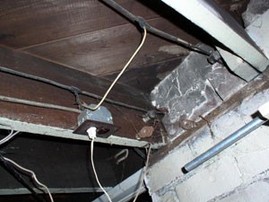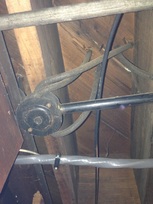- Helping Hands Electric
6725 Seybold Road, Suite B
Madison, WI 53719
Knob and tube wiring (sometimes abbreviated K&T) was an early standardized method of electrical wiring in buildings, in common use in North America from about 1880 to the 1930s. It consisted of single-insulated copper conductors run within wall or ceiling cavities, passing through joist and stud drill-holes via protective porcelain insulating tubes, and supported along their length on nailed-down porcelain knob insulators.
 |
 |
 |
Where conductors entered a wiring device such as a lamp or switch, or were pulled into a wall, they were protected by flexible cloth insulating sleeving called loom. The first insulation was asphalt-saturated cotton cloth, then rubber became common. Wire splices in such installations were twisted together for goodmechanical strength, then soldered and wrapped with rubber insulating tape and friction tape (asphalt saturated cloth), or made inside metal junction boxes.
Knob and tube wiring was eventually displaced from interior wiring systems because of the high cost of installation compared with use of power cables, which combined both power conductors of a circuit in one run (and which later included grounding conductors).
At present, new knob and tube installations are permitted in the US only in a few very specific situations listed in the National Electrical Code, such as certain industrial and agricultural environments.
Knob and tube wiring in residential installations
Purchasers or owners of older homes are finding that many insurers will not provide or renew coverage on such properties. In some cases, the insurance companies are requiring a total replacement of this wiring prior to providing insurance coverage. Over the years wiring installation practices have changed in the residential sector and knob and tube wiring is no longer installed; however, parts continue to be available for maintenance purposes.
Have a licensed electrical contractor check the "knob and tube" conductors in your existing installations for sign of deterioration and damage. The General Inspection report will identify visible electrical safety concerns in your electrical wiring. "Knob & tube" conductors should be replaced where exposed conductors show evidence of mechanical abuse and or deterioration, poor connections, overheating, alterations that result in overloading, or if changes to wiring contravene any section of the National Electrical Code.
Homes with knob and tube wiring may not have the electrical capacity to meet today's needs.
Benefits of new wiring
While knob and tube conductors in good condition and has not been inappropriately altered will not present undue hazards it is worth nothing that modern electrical installations contain safety benefits not found in older electrical systems.
These include:
Homeowners who are planning to modify their knob and tube wiring, or any other electrical wiring, should have the work performed by a licensed electrical contractor.
Helping Hands Electric is license, insure and bonded and is also in full compliance with federal EPA regulations involving the disturbance of lead-based paint in homes built prior to 1978. The regulations allow the disturbance of up to 6 square feet indoors and 20 square feet outdoors of any lead-based painted surface before any special requirements regarding collection and disposal of construction trash become effective.
Interested in hearing more?